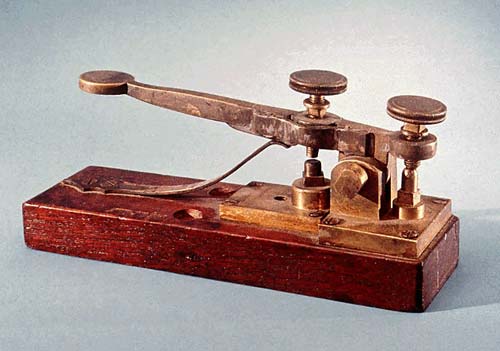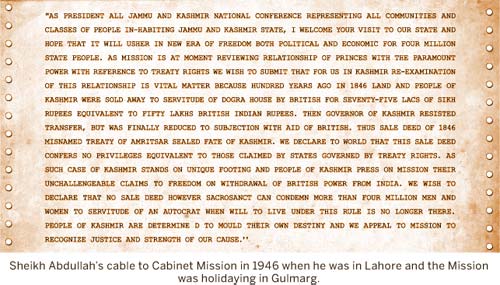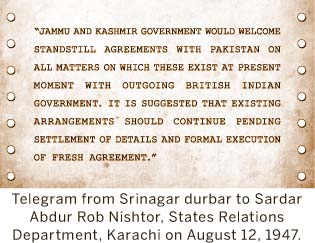Even as telegram was consigned to history after 160 years, historian Ashiq Hussain Bhat says there are numerous telegrams that are fundamental to the history of Kashmir.
The telegraph system was introduced by the British in India in the then capital city of Calcutta in 1850 on an experimental basis. Next year it was opened for use by the East India Company. Initially part of Indian Public Works Department, within two years the whole subcontinent from Calcutta to Peshawar, the last British outpost in India, was interconnected through telegraph wire network. In 1854, Posts and Telegraphs (PnT) department was set up. British Indian Telegraph was a vital tool that strengthened British occupation of India.
Kashmir was connected with the British Indian Telegraph Network via Lahore and remained so even after the 1947-Partition of British India.
In the momentous days of October 1947 the Kashmir Government and the Indian Government communicated with each other through human couriers such as Ram Lal Batra, VP Menon, Dwarka Nath Kachroo, Sheikh Abdullah, but at the same time, they communicated with Pakistan Government through telegrams.
 On the eve of Partition Janak Singh Katotch, the acting Prime Minister of Kashmir, proposed through Telegram of August 12, 1947, a Stand Still Agreement to Pakistan which they agreed to three days later. When Indian Army landed in Kashmir on October 27, Delhi informed Lahore through a telegram that they had decided to fly troops to Kashmir because the Maharaja of that country had acceded to India.
On the eve of Partition Janak Singh Katotch, the acting Prime Minister of Kashmir, proposed through Telegram of August 12, 1947, a Stand Still Agreement to Pakistan which they agreed to three days later. When Indian Army landed in Kashmir on October 27, Delhi informed Lahore through a telegram that they had decided to fly troops to Kashmir because the Maharaja of that country had acceded to India.
The saga of India’s entry into Kashmir had started on 15 October when Maharaja Hari Singh imported Justice Mehr Chand Mahajan from India. No sooner did he assume the office of Dewan(Prime Minister) than he sent a telegram to British Prime Minister Sir Clement Attlee:
“As a result of obvious connivance of the Pakistan Government, the whole of the border from Gurdaspur side up to Gilgit is threatened with an invasion which has actually begun in Poonch. It is requested that the Dominion of Pakistan may be advised to deal fairly with Jammu and Kashmir State and adopt a course of conduct which may be consistent with the good name and prestige of the Commonwealth.”
Many believe, this action of Mahajan was actually a ruse to justify India’s entry into Kashmir. Only two days afterwards Patiala State Army personnel arrived in Srinagar. Patiala was part of Indian Dominion as it had acceded to India. Emboldened by the arrival of Patiala Army, Mahajan sent on October 18, a telegram to Governor General of Pakistan:
“Finally, the Kashmir Government wish to make it plain that it is not possible to tolerate this attitude longer without grave consequences to life and property of the people which it is bound to defend at all costs. The Government even now hopes that you would personally look into the matter and put a stop to all the iniquities which are being perpetrated. If unfortunately this request is not heeded the Government fully hope that you would agree that it would be justified in asking for friendly assistance and oppose trespass on its fundamental rights.”
Next day Prime Minister Liaqat Ali Khan of Pakistan responded by a telegram:
“We are astonished to hear your threat to ask for assistance. Presumably, meaning thereby assistance from an outside power. The only object of this intervention by an outside power secured by you would be to complete the suppression of the Muslims to enable you to join Indian Dominion as coup d’etat against the declared and well-known will of the Mussalmans and others who form 85% of the population of your State. We must earnestly draw your attention to the fact that if this policy is not changed and the preparations and the measures which you are now taking in implementing the policy are not stopped the gravest consequences will follow for which you alone will be held responsible.” (see page136 Kashmir A Disputed Legacy by Alastair Lamb)
On October 27, Indian Army officially entered Kashmir and this fact was also communicated to Pakistan telegraphically. Telegram shall continue to be a source of Kashmir’s recent history even after the vintage communication technology was withdrawn in July 2013.


















